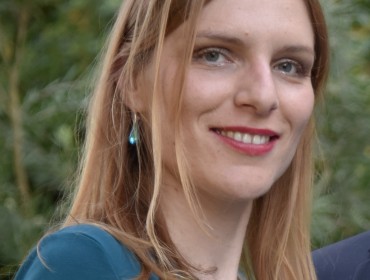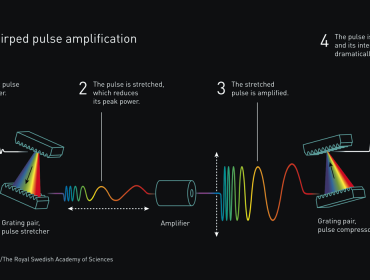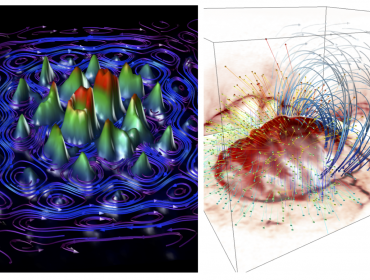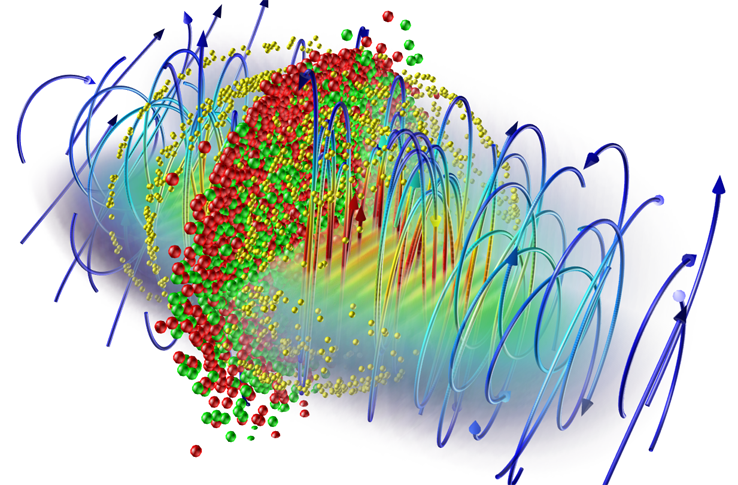-
CERN Accelerator School in Sesimbra 2019: applications are open
Read moreThe next CERN Accelerator School will be co-organized by GoLP from 11 to 22 March 2019, in Sesimbra, Portugal. The school will be devoted to High Gradient Wakefield Accelerators and it will bring to Portugal top specialists in plasma based accelerators. Students are welcomed to apply. More information here.
December 8, 2018 -
Marija V awarded the IBM Prize 2017
Read moreMarija V has been awarded the IBM Prize 2017. This is one of the most prestigious and longest running science prizes in Portugal (this year is the 28th edition) and recognises contributions in computational science and computer science. Previous awardees include epp and GoLP members Luis OS and Samuel Martins. Marija is developing work on computational methods to describe the interactions of light at extreme intensities. Many congratulations to Marija!
November 26, 2018 -
Osiris contributes to the development of a programming environment for the Exascale era
Read moreA new FET project, launched on 1 October 2018, the European joint Effort toward a Highly Productive Programming Environment for Heterogeneous Exascale Computing (3.9 M Euros) aimed at the development and deployment a production-ready parallel programming environment features Osiris as one of the key applications. epp team member Ricardo F is one of the project participants. More information here and here.
November 22, 2018 -
Frederico F awarded Stix Award at APS DPP 2018
Read moreAt the recent APS DPP 2018 meeting, on November 8 2018, GoLP and epp team alumnus Frederico F was awarded the Stix Award of the APS. Fiuza is the fifth awardee (and the 2nd IST alumni to be awarded this prestigious prize to recognise outstanding early career contributions to plasma physics). Many congratulations to Frederico Fiuza.
November 12, 2018 -
epp team raising the bar at APS DPP 2018
Read moreOur team was present at the APS DPP 2018, with an invited talk by Marija V, and contributed talks and poster presentations by Ricardo F, Kevin S, Thales S, Nitin S, Giannandrea I, Fabio C, and Miguel P. The work by Marija V was featured as a press release of the APS DPP 2018 that was highlighted by several outlets (e.g. ScienceDaily, Phys.org and DOE’s NewsWise). The APS DPP 2018 was also another excellent chance to meet all the GoLP and epp team alumni, friends, and collaborators, and to keep up our commitment to continuously raising the bar.
November 12, 2018 -
2018 Nobel Prize in Physics celebrates lasers
Read moreThis year’s Nobel Prize in Physics was shared between Gérard Mourou (École Polytechnique, France), Donna Strickland (University of Waterloo, Canada) and Arthur Ashkin (Bell Laboratories, USA). The work of the first two winners, who were awarded half the prize, consisted of the invention of the Chirped Pulse Amplification (CPA) technique in the mid-1980s, which enabled increasing the power of ultrashort lasers to previously unattainable levels.
Thanks to their invention, ultrashort, ultraintense lasers have become ubiquitous, paving the way for applications ranging from dermatology to ophthalmology and from laser acceleration to pulsed X-ray generation and laboratory astrophysics.
IPFN congratulates the winners, whose work has been seminal to the development of high-intensity lasers and laser-plasma interaction, and celebrates their achievement. The award-winning Gérard Mourou is a long time collaborator of several members of IPFN’s Group for Lasers and Plasmas (GoLP).
Luís Silva, Nelson Lopes and Marta Fajardo worked together with Mourou on the genesis…
October 3, 2018 -
CPA inventors Gérard Mourou and Donna Strickland won the 2018 Nobel Prize in Physics
Read moreThe 2018 Nobel Prize in Physics was awarded to Arthur Ashkin for “optical tweezers and their application to biological systems” and to Gérard Mourou and Donna Strickland for “their method of generating high-intensity, ultra-short optical pulses”. Mourou and Strickland invented the Chirped Pulse Amplification method (CPA) thirty year ago. The CPA method is used to amplify ultra-short laser pulses (from picosecond to femtosecond). The large spectral width of short pulse lasers is used to enlarge the duration of the pulses in a linear dispersive optical path (stretcher). The pulses become linearly chirped (with larger duration and lower power) and are amplified (gain energy) at a comparable lower intensity (below optical materials damage threshold). After the amplification is concluded the pulse (amplified and chirped) is most of the times moved into a vacuum chamber where a dispersive optical path removes the pulse chirp shortening it to almost its original duration….
October 2, 2018 -
epp team awarded multi-year PRACE grant
Read moreOur team has been awarded a multi-year project PRACE allocation in the 17th call for the project PULSAR (first year allocation: 40 million cpu-core hour). This proposal, one of the 42 selected for supercomputing time, addresses the challenges and supports the ERC Advanced Grant InPairs. The allocation is assigned for the great MareNostrum4 at the Barcelona Supercomputing Center. More information here.
September 26, 2018 -
HEDLA 2020 to be organized at IST
Read moreThe Executive Committee of HEDLA has awarded IST the organisation of the next HEDLA meeting to be held in 2020, in the week of May 25 (#HEDLA2020). This will be the 22th anniversary (13th edition) of the HEDLA conference, first organized in Pleasanton, CA in 1996. Previous editions were hosted by Osaka U, SLAC/Stanford, and U. Bordeaux. This conference will be a great opportunity to discuss exciting recent work and future prospects in laboratory astrophysics. During the past decade, research teams around the world have developed astrophysics-relevant research utilizing high energy-density facilities such as intense lasers and z-pinches. Research is underway in many areas, such as compressible hydrodynamic mixing, shock phenomena, magnetic reconnection, turbulence, jets, dynamos, heat conduction, radiative transport, complex opacities, equations of state, warm dense matter, relativistic plasmas, pair plasmas, and QED. HEDLA will showcase these results and will establish further bridges with the astrophysics community.
September 3, 2018 -
AWAKE accelerates electrons
Read moreIn a paper published today, August 29, in the journal Nature, the AWAKE collaboration at CERN, which includes Luis OS, Jorge V, Nelson L, Ricardo F, Mariana M, and Anton H, from GoLP/IST, reports the first ever successful acceleration of electrons using a wave generated by protons zipping through a plasma. The acceleration obtained over a given distance is already several times higher than that of conventional technologies currently available for particle accelerators. First proposed in the 1970s, the use of plasma waves (or so called wakefields) has the potential to drastically reduce the size of accelerators in the next several decades.
The image, by Jorge V, illustrates the concept: the proton beam breaks up in small beamlets (yellow), that drive a plasma wave and the corresponding electric field (blue isosurfaces), that accelerate the co-propagating electrons (small spheres, where color is proportional to the energy of the electrons).
AWAKE,…
August 29, 2018 -
Three papers featured in the new Plasma Physics collection of Nature Communications
Read moreThe new collection of Plasma Physics in Nature Communications features three publications where our team is involved, three of the four sections of the collection (Fundamental Properties of Plasma, Particle Accelerators, and Laboratory and Astrophysical Plasma).
August 9, 2018 -
epp team research featured on Horizons Magazine from the EU
Read moreThe recent issue of the Horizons Magazine, the EU Research & Innovation Magazine features an article about the research of our team in the ERC Advanced Grant InPairs. In the section “Frontier Research”, the article titled “Antimatter plasma reveals secrets of deep space signals“ explores some of the results of two ongoing ERC Advanced Grants, covering both the work at GoLP and the work at the Max Planck Institute for Plasma Physics in Garching, Munich, and how these works bridge the gap between one of the most exotic states of matter (electron-positron plasma) and astrophysical and laboratory conditions.
July 16, 2018 -
GoLP hosts mini course on plasma turbulence by Nuno Loureiro
Read moreOn July 18-20 2018, GoLP will host the mini course “An introduction to turbulence in magnetized plasmas”, by Nuno Loureiro (MIT), aimed at introducing basic notions of turbulence in magnetized plasmas to a non-expert audience. The course will be held at Sala de Reuniões DF (Pavilhão Física) at IST, from 10:30 to 12:00. For further details, see the full announcement below.
An introduction to turbulence in magnetized plasmas
Nuno Loureiro
MIT
Host: Luis Oliveira e SilvaGoLP Mini Course
IPFN :: Instituto de Plasmas e Fusão NuclearThis short course aims to introduce basic notions of turbulence in magnetized plasmas to a non-expert audience. No significant previous knowledge of plasma physics or fluid dynamics is assumed. The course will cover the standard Kolmogorov picture of turbulence in neutral fluids, followed by its extension to magnetohydrodynamics, including the Goldreich-Sridhar (GS95) theory and its recent amendments. The understanding of the latter requires basic notions of magnetic reconnection, which…
July 10, 2018 -
Giannandrea I wins EPS 2018 Best Video in Plasma Physics award
Read moreGiannandrea I has been awarded the EPS 2018 Best Video in Plasma Physics prize at the “45th Conference on Plasma Physics” organized by the European Physical Society and held in Prague (July 2-6 2018). In his video, entitled “Turbulence | Voice of Space”, Giannandrea shows results from recent simulations where plasma in a collisional accretion disk becomes turbulent in the saturation state of kinetic magnetorotational instability (MRI). Besides the mesmerizing turbulent plasma structures, “Turbulence | Voice of Space” also includes a soundtrack that is the sonification of turbulence depicted in the simulations.
July 8, 2018 -
Mini-workshop on strong field physics: from lasers to QCD
Read moreOur team hosted a mini-workshop on strong field physics: from lasers to QCD in collaboration with CeFEMA, including presentations from Sebastien Meuren (Princeton), Thomas G, and Emilio Ribeiro (DF & CeFEMA). The possible connections between QCD and strong field QED were explored with a lively discussion and exploration of possible future directions for research.
June 25, 2018 -
Marija V delivers IST Physics Department Colloquium
Read moreMarija V has delivered the IST Physics Department Colloquium on April 11 with the seminar “Extreme Laser-matter Interactions”. The Physics Department Colloquium is held every week and aims to show case national and international speakers of relevance to the research and educational activities of the IST Physics Department.
April 11, 2018 -
Diana A is awarded her PhD
Read moreDiana A has been awarded her PhD on “Controlled Plasma Wakefield Acceleration for Particle Acceleration Towards the Energy Frontier” under the supervision of Jorge V and co-supervision of Luis OS. The thesis defense took place April 6 2018 in the presence of the thesis committee Profs. L. Alves, R. Bingham, P. Muggli, J.P.Bizarro, and J. Vieira. Many congratulations to the new Doctor Diana Amorim!
April 6, 2018 -
epp team members contribute to solve mystery of why comets emit X-rays
Read moreThe mystery of X-ray emissions from comets has been solved by an international team integrating epp team researchers, Fabio C and Luis OS. This work was published today in Nature Physics.
Scientists have long wondered why comets can radiate X-rays, given that X-rays are normally associated with hot objects like the Sun but comets are among the coldest objects in the Solar system.
When comets travel through the Solar system they interact with the Solar radiation, the Solar wind and the Solar magnetic field. This produces a visible atmosphere (or coma), the characteristic cometary tail, and in some cases X-rays. These X-rays are generated on the sunward side of the comet where the Solar wind impacts the cometary atmosphere forming a bow shock.
To investigate how the X-rays are generated, an international team of scientists from 15 institutes performed experiments using the ultra-intense lasers available at the LULI facility in Paris,…
March 12, 2018 -
The “Natas” of Visualization 2017 have been announced!
Read moreAnd they are “tasty”! Following our tradition (see News for the “2014 Natas”, News for the “2015 Natas”, News for the “2016 Natas”), the prizes for the winners of the image and video of 2017, the “natas” of visualization, were awarded to Fabio Cruz (left, and triple winner after wins in 2014 and 2016) and to Fabrizio Del Gaudio (right). The term “Nata” was coined by one of the previous winners Paulo Alves: “Nata” is a tasty Portuguese pastry that everybody likes. It’s as enjoyable as having our simulations running nicely on a big supercomputer. It can also mean being at the top, at a high level, important.” Many congratulations to the 2017 winners! The images and videos will be posted on the team website and over the next few weeks on GoLP’s Facebook page.
January 15, 2018 -
Paper by Thomas G et al selected as PoP Impactful articles from 2017
Read moreThe paper “Laser absorption via quantum electrodynamics cascades in counter propagating laser pulses” by Thomas Grismayer et al has been selected by Physics of Plasmas in the collection of Impactful articles from 2017. This is a collection of top articles of 2017. The list is comprised of most cited, most downloaded, DPP Special Issue articles, and Editor’s Picks. These articles have been made free to download for a limited time.
January 9, 2018
Group for Lasers and Plasmas > News



























